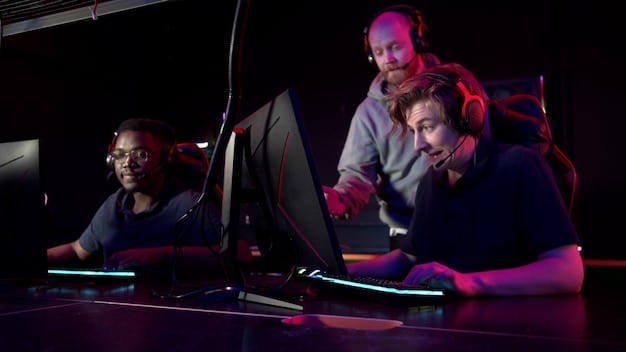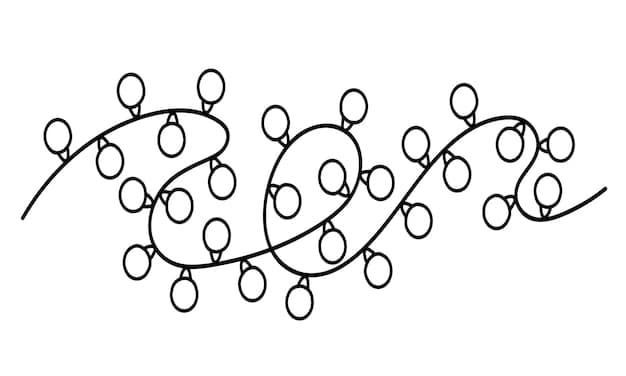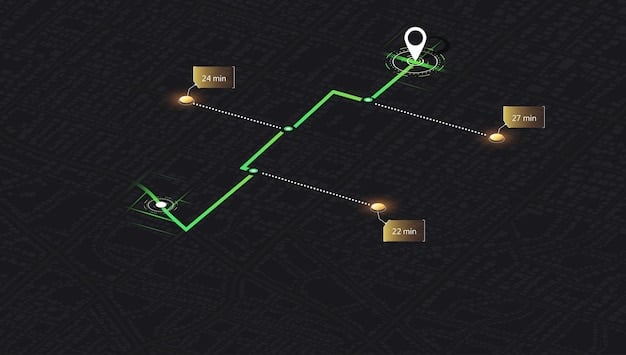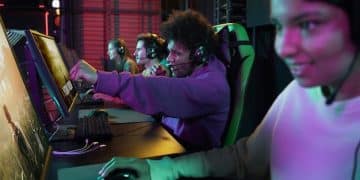Version Control for Game Development: Git & GitHub Collaboration

Version control, particularly using Git and GitHub, is fundamentally transforming collaborative game development by providing developers with robust tools for managing code changes, tracking project history, and streamlining teamwork while mitigating common production challenges.
In the evolving landscape of interactive entertainment, the complexity of game development demands more than just creative vision; it requires streamlined processes and efficient collaboration. At the heart of successful modern game projects lies an often-underestimated hero: version control for game development: using Git and GitHub for collaboration. This foundational practice not only safeguards your creative efforts but also empowers teams to work in harmony, ensuring that every line of code, every art asset, and every design iteration is meticulously tracked and integrated. In this deep dive, we’ll explore why Git and GitHub are indispensable tools for any serious game developer, offering insights into how they bolster productivity, reduce headaches, and foster a truly collaborative environment.
The critical role of version control in game development
Modern game development is a multifaceted endeavor, often involving large teams of programmers, artists, designers, and sound engineers, all contributing to a single project. Without a systematic way to manage these contributions, chaos quickly ensues. Version control systems (VCS) provide the necessary structure to track changes, reconcile conflicts, and maintain a clear history of the project’s evolution.
Historically, game studios might have relied on shared drives and manual backups, a risky approach prone to overwrites and lost work. The advent of distributed version control systems like Git revolutionized this process. Git allows every developer to have a complete copy of the project repository, enabling them to work offline and merge their changes with the main project seamlessly. This decentralization significantly enhances resilience and flexibility in development workflows.
Why game development demands robust version control
Game projects are notorious for their large file sizes, frequent changes, and the sheer number of interdependent assets. A single change in a texture, a character model, or a script can have ripple effects across the entire game. Version control makes these changes manageable, reversible, and traceable, preventing small errors from escalating into catastrophic project setbacks.
- Mitigating data loss: Every commit acts as a snapshot, allowing developers to revert to previous stable versions if issues arise.
- Enabling concurrent development: Multiple team members can work on different parts of the project simultaneously without overwriting each other’s work.
- Streamlining code reviews: Changes can be reviewed and approved before being integrated, improving code quality and catching bugs early.
Imagine a scenario where an artist updates a character model, and a programmer simultaneously adjusts the character’s movement script. Without version control, manually merging these changes would be a nightmare, risking data corruption or missed updates. Git automates this merging process, identifying conflicts and providing tools to resolve them efficiently. This seamless integration is crucial for maintaining development velocity and team morale.
Furthermore, version control is invaluable for post-launch support and updates. When a bug is reported in a live game, developers can pinpoint the exact change that introduced the defect, accelerating the debugging process and delivering faster fixes to players. This historical traceability is a cornerstone of professional game development, ensuring accountability and improving long-term project maintainability. The ability to experiment with new features on separate branches, without affecting the main codebase, fosters innovation and reduces the risk associated with bold creative decisions.
Understanding Git fundamentals for game developers
Git, a distributed version control system, operates on the principle of snapshots, not differences. When you “commit” changes, Git records the state of your entire project at that moment. This fundamental difference from older VCS (like SVN) is key to its power and flexibility, especially for handling large binary assets common in game development.
For game developers, mastering Git begins with understanding a few core concepts: repositories, commits, branches, and merges. A repository is simply your project’s folder, tracked by Git. A commit is a snapshot of your repository at a specific point in time, usually accompanied by a descriptive message. Branches allow you to diverge from the main line of development to work on new features or bug fixes independently, while merges bring divergent branches back together.
Essential Git commands and workflow
While Git can seem complex at first, a few commands form the backbone of everyday game development workflows:
git init: Initializes a new Git repository in your project folder.git add .: Stages all changed files for the next commit.git commit -m "Your commit message": Records the staged changes as a new commit.git pull: Fetches and merges changes from a remote repository.git push: Uploads your local commits to a remote repository.git branch [branch-name]: Creates a new branch.git checkout [branch-name]: Switches to a specific branch.git merge [branch-name]: Integrates changes from one branch into another.
A typical workflow might involve: pulling the latest changes from the main branch, creating a new branch for a feature, making changes and committing them incrementally, testing the feature, and then merging it back into the main branch. This structured approach minimizes conflicts and ensures that the main branch remains stable and functional.
One common challenge for game developers is dealing with large binary files (like textures, models, and audio files) which Git is not inherently optimized for. Storing these directly in a Git repository can lead to slow clone times and bloated repository sizes. This is where tools like Git Large File Storage (LFS) come into play, providing a crucial extension to Git that handles large files by storing pointers in the repository while the actual files are kept on a remote server. This significantly improves performance and manages repository size for asset-heavy projects.

Understanding the staging area is another nuanced but powerful aspect of Git. The git add command doesn’t just add files to a commit; it adds them to a “staging area” or “index.” This allows developers to craft precise commits, including only the relevant changes, even if other modifications exist in their working directory. This granularity provides greater control over the project’s history and simplifies reverts and merges. Effective use of Git’s branching and merging capabilities is what truly unlocks its potential for large, multi-contributor game projects, allowing for agile development and continuous integration.
Leveraging GitHub for collaborative game development
While Git is the engine for version control, GitHub acts as the collaborative platform that hosts Git repositories, providing a central hub for teams to share code, track issues, and manage projects. For game developers, GitHub offers invaluable features that extend beyond basic version control, fostering a truly collaborative ecosystem.
GitHub provides a user-friendly web interface to manage repositories, view commit histories, and execute many Git operations without needing the command line. Its powerful collaborative features, such as pull requests, issue tracking, and project management boards, are particularly beneficial for complex game development cycles.
Key GitHub features for game teams
- Repository hosting: A centralized remote location for all project files, accessible to the entire team.
- Pull requests: A mechanism for proposing changes, discussing them with the team, and integrating them into the main codebase after review. This is crucial for maintaining code quality and catching bugs.
- Issue tracking: A system to log bugs, feature requests, and tasks, allowing teams to prioritize and assign work efficiently.
- Project boards: Kanban-style boards to visualize workflow, track progress, and manage sprints effectively.
- Wikis and documentation: Built-in tools for creating project documentation, guidelines, and design documents.
Actions and CI/CD: Automation workflows for continuous integration and continuous deployment, enabling automated testing and build processes.
Consider a team of artists working on character animations. They can create a new branch, upload their work, and then submit a pull request. Programmers or other artists can review the animations directly on GitHub, provide feedback, and approve the merge into the main branch. This streamlined review process is far more efficient than exchanging files via email or shared drives, reducing errors and saving significant time.
Beyond code, GitHub’s robust issue tracking and project boards are instrumental in managing the myriad tasks involved in game development. Bugs reported by testers can be logged directly into GitHub Issues, assigned to the relevant developer, and tracked until resolution. This transparency ensures that no task falls through the cracks and that the project progresses smoothly. Integrating GitHub with popular game engines like Unity or Unreal Engine can further streamline asset management and code deployment, creating a powerful synergy for development teams.
Best practices for Git & GitHub in game dev workflows
Implementing Git and GitHub effectively in game development goes beyond understanding the basic commands; it involves adopting best practices that optimize collaboration, maintain project stability, and handle the unique challenges of game assets. Without a clear strategy, even the most powerful tools can lead to disorganization.
A well-defined Git workflow is paramount. Many teams opt for a feature-branch workflow, where each new feature or bug fix is developed on its dedicated branch. This isolates changes, preventing instability in the main development line and allowing for parallel work streams. Once a feature is complete and tested, it’s merged back into the main branch via a pull request.
Strategies for efficient version control in game development
- Use Git LFS for large assets: As discussed, Git Large File Storage (LFS) is essential for managing binary assets like textures, audio, and models. It keeps your main repository lean while tracking large files efficiently.
- Establish clear branching strategies: Decide on a consistent branching model (e.g., Git Flow, GitHub Flow) and ensure all team members adhere to it. This provides structure and predictability.
- Commit frequently and with descriptive messages: Small, atomic commits make it easier to track changes, revert mistakes, and understand the project’s history. Descriptive commit messages are crucial for context.
- Regularly pull and resolve conflicts: Encourage team members to pull the latest changes from the main branch frequently. This minimizes the scope of merge conflicts and makes them easier to resolve when they occur.
- Implement code reviews for all merges: Use pull requests as a mandatory step for integrating changes. This promotes collaboration, knowledge sharing, and quality assurance.
- Set up .gitignore for temporary files: Properly configure your
.gitignorefile to exclude temporary files, build artifacts, and user-specific editor settings from being tracked by Git. This keeps your repository clean and relevant. - Utilize GitHub’s project management features: Leverage Issues, Project Boards, and Milestones to track tasks, bugs, and overall project progress efficiently.
For example, when an artist is working on new character costumes, they would create a branch like feature/new-costumes. They commit their work incrementally, perhaps one commit for each costume variant. Once all costumes are ready and tested within the game engine, they create a pull request to merge feature/new-costumes into the main develop branch. A designer or another artist can review the visual assets, ensuring they meet the project’s standards, before approving the merge. This systematic approach eliminates guesswork and reduces the likelihood of integration issues, fostering a predictable and productive development environment.
Integrating Git and GitHub with game engines
One of the most critical aspects of adopting Git and GitHub for game development is ensuring seamless integration with the chosen game engine. While Git isagnostic to file types, game engines like Unity and Unreal Engine have specific needs and behaviors that developers must consider to optimize their version control workflow.
Each engine has its own way of managing project files, assets, and metadata. Understanding these nuances is key to configuring Git and GitHub efficiently, preventing common pitfalls such as tracking unnecessary files, handling large binary assets, and resolving scene merge conflicts. The goal is to make the version control system act as an extension of the engine’s development environment, not an obstacle.
Engine-specific considerations for Unity and Unreal Engine
- Unity:
- YAML merge conflicts: Unity’s scene and prefab files are often serialized in YAML, which can lead to complex merge conflicts. Using “Force Text” asset serialization mode in Unity helps make these files more human-readable and thus merge-friendly.
- Library folder: The
Libraryfolder in Unity projects contains generated files and should generally be ignored by Git to avoid tracking unnecessary data and massive repository sizes. - Git LFS integration: Essential for large assets like textures, models, and audio. Unity projects often contain many binary assets that would bloat a standard Git repository.
- Smart merge tools: Tools designed specifically for Unity YAML merges can significantly simplify conflict resolution.
- Unreal Engine:
- Binary assets: Unreal Engine’s assets (e.g.,
.uassetfiles) are typically binary. Git LFS is non-negotiable for these. - Derived Data Cache (DDC): Similar to Unity’s Library folder, Unreal’s DDC contains derived data and should be ignored, as it can be regenerated locally.
- Source control plugins: Unreal Engine has built-in source control plugins that can integrate directly with Git, allowing some Git operations (like committing and pulling) directly from the editor.
- Perforce vs. Git consideration: While Git is excellent for many teams, very large Unreal projects (especially those with many artists) sometimes opt for Perforce due to its strengths in handling massive binary files and stricter locking mechanisms, though Git LFS mitigates many of Git’s traditional weaknesses in this area.
- Binary assets: Unreal Engine’s assets (e.g.,
For both engines, a well-crafted .gitignore file is perhaps the single most important configuration. It dictates which files Git should track and which it should explicitly ignore. Incorrectly configured .gitignore files can lead to massive repositories filled with unnecessary build artifacts or, worse, critical files being untracked. Community-maintained .gitignore templates for Unity and Unreal Engine provide excellent starting points, which teams can then customize based on their specific project needs.
Regular communication within the team about asset management, file naming conventions, and Git usage protocols is also vital. Whether it’s agreeing on how to handle shared prefabs in Unity or ensuring artists save their .uasset files correctly in Unreal, a consistent approach minimizes version control headaches. The goal is to treat the game engine and Git/GitHub as a unified system, allowing developers to focus on creativity and innovation rather than wrestling with file management. This symbiotic relationship ensures that the version control system enhances, rather than hinders, the iterative nature of game development.
Addressing common challenges and advanced Git features
While Git and GitHub offer immense power to game development teams, their adoption isn’t without challenges. Large asset files, binary merge conflicts, and maintaining a clean history are common hurdles. Fortunately, Git provides advanced features and workflows to tackle these issues head-on, turning potential roadblocks into opportunities for refinement.
The first major challenge is undoubtedly dealing with large binary assets. Standard Git struggles with these because it stores a full copy of every version of every file, making repositories bloated and slow to clone. This is where Git LFS (Large File Storage), as mentioned earlier, becomes indispensable. It replaces large files in your Git history with small text pointers, storing the actual binary content on a separate LFS server. This significantly improves performance and manages repository size.
Advanced Git strategies for smoother pipelines
- Git LFS configuration and maintenance: Beyond initial setup, regularly review your LFS tracking rules. Ensure that all relevant large asset types (e.g.,
.fbx,.wav,.psd,.uasset,.unity) are correctly configured for LFS. Understand LFS quotas and server-side storage implications. - Submodules for external dependencies: For projects that rely on shared libraries, engine plugins, or other distinct sub-projects, Git submodules can be useful. They allow you to embed one Git repository inside another as a subdirectory, maintaining its own version history independently.
- Rebasing vs. merging: While merging integrates branches by creating a new merge commit, rebasing rewrites the commit history to place your branch’s commits on top of the main branch. Rebasing creates a cleaner, linear history, which can be easier to read, but it should be used with caution on shared branches as it rewrites history.
- Sparse checkouts and shallow clones: For very large repositories, developers might not need every file or the entire history. Sparse checkouts allow you to download only specific directories, and shallow clones let you download only a limited number of past commits, significantly reducing local repository size and clone time.
- Post-commit hooks and automation: Git hooks are scripts that Git executes automatically before or after events like committing or pushing. These can be used for automated testing, code linting, or even updating game build servers, enhancing continuous integration.
- Handling binary merge conflicts with external tools: While Git LFS helps with storage, direct merge conflicts in binary files (like scene files or prefabs) often require specialized merge tools provided by game engines or third-party solutions. Educating the team on best practices for avoiding and resolving these conflicts is paramount. Tools like GitKraken Client or Sourcetree offer visual interfaces that can simplify complex Git operations and conflict resolution, making it more accessible for artists and designers who might be less familiar with the command line.

Effectively addressing these challenges requires not only technical understanding but also clear team communication and adherence to established protocols. Regular team meetings to discuss workflow issues, review pull request best practices, and share knowledge about advanced Git features can empower developers to leverage the full potential of Git and GitHub, leading to more robust projects and a more efficient development cycle.
The future of version control in game development
As game development continues to evolve, driven by innovations in graphics, networked experiences, and iterative design, the demands on version control systems will only increase. While Git and GitHub have cemented their place as industry standards, the landscape is not static. We are seeing continuous improvements in these tools and the emergence of specialized solutions tailored for the unique complexities of game assets.
Future trends suggest a move towards even more integrated and intelligent version control, particularly for artists and designers who may not be comfortable with command-line interfaces. Visual Git clients continue to improve, offering intuitive drag-and-drop interfaces for common operations, abstracting away much of Git’s underlying complexity. Furthermore, game engine developers are investing more in native source control integrations, making it even easier for teams to manage assets directly within their preferred development environment.
Emerging trends and continued evolution
- Enhanced Git LFS capabilities: Expect further refinements in how Git LFS handles massive numbers of small binary assets and very large single files, potentially with better caching and distribution mechanisms.
- Cloud-native version control: Services built directly into cloud platforms (e.g., Azure DevOps, AWS CodeCommit) that offer Git hosting alongside other development tools are gaining traction, providing integrated CI/CD pipelines and scalable storage solutions.
- Specialized asset-focused VCS: While Git LFS bridges the gap, some studios may still explore purpose-built asset management systems or hybrid solutions that combine the strengths of Git for code with dedicated systems for art assets (e.g., Perforce Helix Core for large-scale AAA projects).
- AI-assisted conflict resolution: As AI capabilities advance, we might see tools that can intelligently suggest resolutions for complex merge conflicts, especially in structured data formats like JSON or XML used in game configuration files.
- Decentralized alternatives: While Git is distributed, fully decentralized systems leveraging blockchain or similar technologies could emerge, offering new paradigms for open-source game development and asset ownership in the future.
The underlying philosophy, however, remains consistent: to provide a robust, reliable, and efficient means for collaborative development. Whether through new features in GitHub, improved integration with game engines, or the advent of novel version control paradigms, the goal is always to empower game developers to create without fear of data loss or integration nightmares. The industry’s push towards larger teams, more frequent updates, and live service games underscores the enduring importance of powerful and flexible version control systems as the backbone of modern game production. Maintaining a continuous learning mindset and adapting to these advancements will be crucial for staying at the forefront of game development.
| Key Point | Brief Description |
|---|---|
| 🚀 Benefits of VCS | Ensures data integrity, enables concurrent work, and facilitates seamless collaboration for game development teams. |
| 🔗 Git & GitHub Synergy | Git is the core version control; GitHub provides the collaborative platform with features like pull requests and issue tracking. |
| 💾 Git LFS Importance | Crucial for managing large binary game assets efficiently, preventing repository bloat and slow operations. |
| 🛠️ Engine Integration | Tailoring Git setups for Unity/Unreal (e.g., .gitignore, text serialization) is essential for smooth workflows. |
Frequently asked questions about version control for game development
▼
Even small teams benefit immensely from version control. It prevents accidental overwrites, makes it easy to revert to previous versions if a bug is introduced, and allows team members to work on separate features concurrently. This significantly reduces project risks and boosts productivity, ensuring creative flow isn’t interrupted by technical hiccups.
▼
Git is the distributed version control system—the software that tracks changes in your code and assets locally. GitHub is a web-based hosting service for Git repositories, providing a platform for collaboration, issue tracking, and project management, making it easier for teams to work together on shared projects remotely.
▼
Game development often involves large binary files like 3D models, textures, and audio. Git LFS replaces these large files with small text pointers in your Git repository, storing the actual binary data on a separate LFS server. This prevents your repository from becoming bloated and slow, improving cloning, pushing, and pulling times significantly.
▼
Absolutely. While the command line is powerful, many user-friendly Git GUI clients (e.g., GitHub Desktop, GitKraken, Sourcetree) offer visual interfaces that simplify complex Git operations. These tools allow artists and designers to commit changes, pull updates, and manage branches with minimal technical expertise, fostering broader team participation in version control.
▼
Resolving binary or complex YAML merge conflicts often requires specialized tools or careful manual intervention. For Unity, using “Force Text” serialization helps. For both, careful communication, working on separate branches for distinct features, and specialized merge tools (some integrated into engines) are crucial. Regular, small commits can also minimize the scope of conflicts.
Conclusion
The journey through game development, from initial concept to final release, is replete with technical and creative challenges. At every step, the meticulous management of project assets and code is paramount. It is here that version control, specifically by leveraging the combined power of Git and GitHub, emerges not merely as a tool, but as a fundamental pillar of modern game production. By embracing these systems and adhering to best practices, development teams can navigate the complexities of concurrent work, safeguard against data loss, streamline collaboration, and ultimately, focus their energy on crafting truly exceptional games. The investment in understanding and integrating Git and GitHub is an investment in the stability, efficiency, and collaborative spirit that drives successful game development endeavors in today’s dynamic industry.





